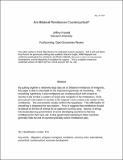| dc.contributor.author | Frankel, Jeffrey A. | |
| dc.date.accessioned | 2012-09-27T15:05:42Z | |
| dc.date.issued | 2011 | |
| dc.identifier.citation | Frankel, Jeffrey A. 2011. Are Bilateral Remittances Countercyclical? Open Economies Review 22(1): 1-16. | en_US |
| dc.identifier.issn | 0923-7992 | en_US |
| dc.identifier.uri | http://nrs.harvard.edu/urn-3:HUL.InstRepos:9642640 | |
| dc.description.abstract | By putting together a relatively large data set on bilateral remittances of emigrants, this paper is able to shed light on the important hypothesis of smoothing. The smoothing hypothesis is that remittances are countercyclical with respect to income in the worker’s country of origin (the recipient of the remittance), while procyclical with respect to income in the migrant’s host country (the sender of the remittance). The econometric results confirm the hypothesis. This affirmation of smoothing is important for two reasons. First, it suggests that remittances should be placed on the list of criteria for an optimum currency area. Second, it brings into doubt plans by governments in some developing countries to harness remittances for their own use, in that government spending in these countries generally fails the test of countercyclicality which remittances pass. | en_US |
| dc.language.iso | en_US | en_US |
| dc.publisher | Springer | en_US |
| dc.relation.isversionof | http://dx.doi.org/10.1007/s11079-010-9184-y | en_US |
| dash.license | OAP | |
| dc.subject | bilateral remittances | en_US |
| dc.subject | smoothing | en_US |
| dc.subject | immigration | en_US |
| dc.subject | international economics | en_US |
| dc.title | Are Bilateral Remittances Countercyclical? | en_US |
| dc.type | Journal Article | en_US |
| dc.description.version | Accepted Manuscript | en_US |
| dc.relation.journal | Open Economies Review | en_US |
| dash.depositing.author | Frankel, Jeffrey A. | |
| dc.date.available | 2012-09-27T15:05:42Z | |
| dc.identifier.doi | 10.1007/s11079-010-9184-y | * |
| dash.contributor.affiliated | Frankel, Jeffrey | |


